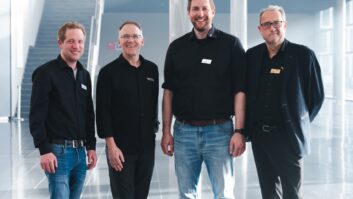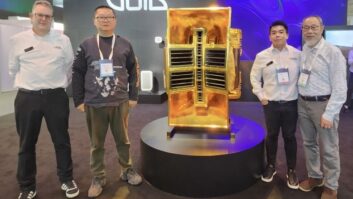Previously we revealed how the fortunes of different sectors and technologies in AV will change over the next 10 years, before looking at how the layer of intelligence in AV solutions will increase. Here Ian McMurray asks the industry how it is responding to growing understanding of environmental issues as well as how the relationship between vendors/integrators and end users is changing.
A theme that will continue to impact the AV industry is the growing eco-awareness of end users. To respond, Frank Reynolds, who is European marketing manager at Antycip Simulation, believes that suppliers like Antycip will need to take a view beyond minimising the power consumption of equipment.
“Environmental concerns have been becoming more predominant in the business we conduct,” he notes, “making companies like ourselves more responsible for the waste we create within an installation, and accountable for how the manufacturers of the technologies we represent dispose and recycle their goods as well as how those goods operate in terms of their carbon footprint and so on.”
“And,” he adds, “collaborative VR will help to reduce travel in business and connect companies like never before – while being more environmentally friendly.”
Immersive audio is, for some, a prerequisite of VR experiences, and to a lesser extent of collaboration applications – but, in general, it seems few see it as being particularly influential in the years to come.
Of all the potential influences on the AV industry between now and 2030, there is widespread agreement that the user experience will dominate.
“Smart spaces and technologies are proving that they can inform and entertain users,” says Carl Standertskjold, European corporate segment marketing manager, Sony Professional. “However, the current AV technology landscape has become so vast that creating a meaningful environment that resonates with a business and its workers is increasingly challenging. In the next 10 years, customisability and flexibility will be key to empowering companies to create tech-enhanced workplaces that enrich the human experience. Alongside significant improvements in well-thought-out workplace environments, we are already starting to see most projects looking for more customised solutions and automation is central to this.”
“Automation and connectivity are at the core of any workplace UX,” he continues. “Through the integration of meeting rooms, projectors, displays and booking systems, a workplace can be transformed into a space that works for the employees, rather than employees adjusting to an inefficient office. The impact over the next 10 years will be driven by increased efficiency and productivity as a result of improved physical and digital UX integration.”
Evolving channel
Where the industry appears to be in most agreement, however, is not about the technologies, products and applications of the future – it’s about how these will come to market, and the evolving nature of the relationship between vendors/integrators on the one hand, and end users on the other. The recurring theme is what else sellers will need to offer beyond what they do today – not least in response to an increasingly price-sensitive market.
“Margins on hardware are reducing, so integrators will need to seek other means to increase their bottom line,” advises Robin van Meeuwen, founder and CEO of TIG. “Recurring revenue models and managed services are key.”
That’s unquestionably a shift that the channel has already begun to make – but that it needs to redouble its efforts appears to be the industry consensus.
“Margins on hardware are reducing, so integrators will need to seek other means to increase their bottom line”
Robin van Meeuwen, TIG
“The economic value of integrators is shifting towards customer lifetime value,” says Martin Barbour, product manager, Q-SYS Cloud Software at QSC. “No longer will our relationships with our customers be about a one-time purchase. Integrators will be able to offer additional services that can help their customer enhance and better understand their AV investment, while offering integrators new opportunities to grow their business.”
“There is a clear opportunity for integrators to expand upon the value-add they bring,” agrees Sean Wargo, who is senior director of market intelligence for AVIXA, “shifting them from what used to be pure installation toward consultation and design of the overall user experience. They even have opportunities in content creation itself as the client base seeks more from its providers. Mergers, acquisitions, and partnerships will all play a role in enabling the expansion of capabilities in this fashion. So too will creative use of financing and capital. We are seeing it now and will see more as we go through the next 10 years.”
Pressure
Claire Kerrison, senior market analyst professional displays at Futuresource, sees things similarly. “AV Managed Services will certainly have a significant impact on channel dynamics,” she says. “Some brands will provide it themselves whilst others will partner with a leading integrator. Regardless, it will certainly put pressure on distributors and resellers working in the corporate space, possibly even in education.”
“The next decade will see further merging of roles within the channel as each type battles to remain relevant. The adage ‘go big, go niche or go home’ will become increasingly pertinent,” she smiles.
And that, it seems, is not the only threat. For Rob Smith, senior director, integrated systems sales at Shure, the huddle room phenomenon – if it can still be called that – will be a game-changer in a perhaps unexpected way. “A trend we are seeing is the increasing number of standard, small meeting room deployments,” he explains. “This has not directly reduced the number of larger, more complex installations, including auditoriums and multi-function spaces – but for integrators to have access to these traditional opportunities, they will need to have a way of addressing the smaller, more numerous rooms as well. The lower level of complexity in these spaces will probably mean that high level engineering capability will become only one of the core offerings of larger integrators and the ability to provide a global deployment capability, fast turnaround solutions and a support model that works for a much higher number of rooms will become equally – if not more – important for continued success. The good news is that the growth potential for those companies that can address the new AV/IT world is significant.”
Klas Dalbjörn, product manager at Powersoft, provides a fairly terse summary. “The integrator will either need to step out of his comfort zone, if he hasn’t already, and become a true system integrator – or accept being a sub-supplier.”
www.antycipsimulation.com
www.avixa.org
www.futuresource-consulting.com
www.powersoft-audio.com
www.qsc.com
www.shure.eu
www.sony.com
www.tig.eu







